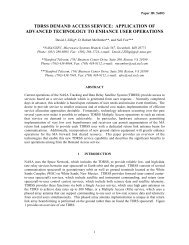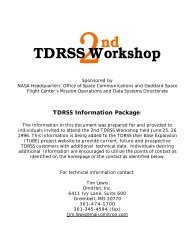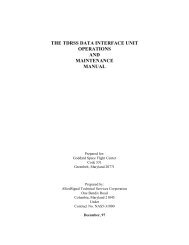Operational Interface Procedures for the South Pole TDRSS Relay ...
Operational Interface Procedures for the South Pole TDRSS Relay ...
Operational Interface Procedures for the South Pole TDRSS Relay ...
You also want an ePaper? Increase the reach of your titles
YUMPU automatically turns print PDFs into web optimized ePapers that Google loves.
While TDRS-1 is supported at <strong>the</strong> White Sands Ground Terminal (WSGT), <strong>the</strong> router is<br />
connected by Fiber Optic Transceivers (FOT) through <strong>the</strong> WSC Inter-Facility Link (IFL)<br />
to <strong>the</strong> Cisco 4500 router at <strong>the</strong> Second <strong>TDRSS</strong> Ground Terminal (STGT). The data <strong>the</strong>n<br />
is <strong>for</strong>warded to <strong>the</strong> Integrated Digital Network Exchange (IDNX) equipment at WSC<br />
which multiplexes/switches <strong>the</strong> data in a NASA Integrated Services Network (NISN)<br />
channel. The data is <strong>the</strong>n placed on <strong>the</strong> NASA Science Internet (NSI) Internet and<br />
routed to <strong>the</strong> requested destination.<br />
e. High data rate K-band service data is <strong>for</strong>warded from <strong>the</strong> WSC LRDS to <strong>the</strong> White<br />
Sands File Server (WSFS).<br />
f. Users data files are <strong>the</strong>n accessed by <strong>the</strong> users by FTP’ing <strong>the</strong>m from <strong>the</strong> WSFS fileserver<br />
via <strong>the</strong> NSI.<br />
NOTE<br />
See Figure 1-1, SPTR Data Flow Diagram.<br />
1.3.3 GOES/LES Data Flow Description<br />
1.3.3.1 General<br />
a. <strong>South</strong> <strong>Pole</strong> scientific data communications also is supported by <strong>the</strong> GOES-3 and LES-9<br />
satellites <strong>for</strong> <strong>the</strong> National Science Foundation (NSF). The communications systems are<br />
operated and maintained by University of Miami, Malabar Ground Station, located in<br />
Malabar, Florida.<br />
b. User traffic data in IP <strong>for</strong>mat is routed via <strong>the</strong> NSI to <strong>the</strong> University of Miami Network<br />
and <strong>the</strong>n <strong>for</strong>warded to <strong>the</strong> router at <strong>the</strong> Malabar Ground Station. From <strong>the</strong>re <strong>the</strong><br />
command data is routed via ei<strong>the</strong>r <strong>the</strong> GOES-3 or LES-9 satellite to <strong>the</strong> <strong>South</strong> <strong>Pole</strong>.<br />
User data cannot be routed simultaneously via both satellites but can be routed<br />
simultaneously via ei<strong>the</strong>r satellite or <strong>the</strong> TDRS F1 satellite. The NSI router scheme<br />
employed <strong>for</strong> co-existence will route traffic via <strong>TDRSS</strong> first.<br />
NOTE<br />
When real time communication is not possible, message traffic can<br />
be stored on a 24-hour a day file server at <strong>the</strong> Malabar Ground<br />
Station to be <strong>for</strong>warded as soon as possible when <strong>the</strong> GOES-<br />
3/LES-9 links become available or can be sent via <strong>the</strong> SPTR.<br />
c. User data is transmitted from <strong>the</strong> <strong>South</strong> <strong>Pole</strong> LAN in TCP/IP <strong>for</strong>mat via ei<strong>the</strong>r <strong>the</strong><br />
GOES-3 or LES-9 satellite to <strong>the</strong> Malabar Ground Station and <strong>the</strong>n <strong>for</strong>warded to <strong>the</strong><br />
users via <strong>the</strong> University of Miami network and <strong>the</strong> NSI. See figure 1-1, SPTR Data Flow<br />
Diagram.<br />
a2302s1 1-3 532-OIP-NCC/SPTR






